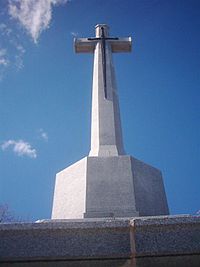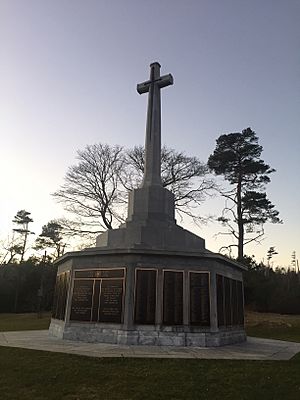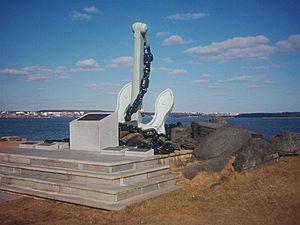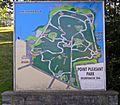Point Pleasant Park facts for kids
Quick facts for kids Point Pleasant Park |
|
|---|---|

Point Pleasant Park
|
|
| Type | Public park |
| Location | Halifax, Nova Scotia |
| Area | 75 ha (190 acres) |
| Created | 1866 |
| Operated by | Halifax Regional Municipality (Land under lease from Government of Canada) |
Point Pleasant Park is a big, mostly forested park located at the very end of the Halifax peninsula. It used to have many old forts, and you can still see the Prince of Wales Tower there. This tower was built in 1796 and is the oldest Martello tower in North America!
The park is a super popular place for people from Halifax to visit. You can walk through the woods, enjoy amazing views of the harbour, and look out at the Atlantic.
Every summer, a professional theatre group called Shakespeare by the Sea performs plays in the park. They put on Shakespeare plays and fun musicals based on classic fairy tales for everyone to enjoy. These shows happen at Cambridge Battery. The group also has a small indoor theatre called Park Place Theatre. It's used when it rains in the summer, and for shows in the fall and winter.
The British government actually owns Point Pleasant Park. They lease it to the Halifax Regional Municipality for a very small fee – just one shilling per year! This agreement was made way back in 1866 by Sir William Young.
Contents
Park History
Early Days (18th-19th Century)
St. Aspinquid Chapel
A special place called St. Aspinquid's Chapel was built by a priest named Louis-Pierre Thury in the late 1600s. It's a natural stone area near Chain Rock Battery in the park. Many important people were buried in the grounds around the chapel. The Mi’kmaq people also held a big celebration there called the Feast of St. Aspinquid for many years. This chapel was even the site of a battle between two Mi'kmaq chiefs in 1760 during the French and Indian War.
Halifax Begins
In 1749, Edward Cornwallis arrived in Halifax. The British Government sent him to create a large military and civilian settlement. He first tried to settle in Point Pleasant Park, but it was too open to the weather. So, he moved the settlement closer to Citadel Hill. Halifax became a very important place for the British. Forts were built mainly to stop enemy ships from entering Halifax Harbour. The first forts in Point Pleasant Park were built near the end of the French and Indian War.
Seven forts were built in total: Chain Rock, Chain Battery, Point Pleasant Battery, Northwest Arm Battery, Fort Ogilvie, Prince of Wales Tower, and Cambridge Battery. Most of these were rebuilt or changed several times over the next 200 years.
French and Indian War Forts
Four defence spots were built during the French and Indian War: Chain Battery, Chain Rock, Point Pleasant Battery, and Northwest Arm Battery. These forts were made from logs, earth, and stone. They had fireplaces for warmth, and later, furnaces to heat up cannonballs.
Chain Battery and Chain Rock were simple forts built into the natural land to protect the Northwest Arm. This battery was not rebuilt later, so it still looks like it did in 1762. Because it was left alone so early, the area has grown back into a forest. Point Pleasant Battery is one of the oldest forts. Even though it was first built in 1762, what you see today is mostly from the early 1900s.
The fourth fort, the Northwest Arm Battery, was built during the war. It was damaged in 1895 and started falling into the sea. So, it was moved further along the Northwest Arm shore. This battery was first built in 1762 and stopped being used after the 1860s.
French Revolutionary Wars
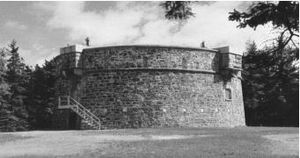
In 1792, during the French Revolutionary Wars, the British military in Halifax worried about a possible attack from France. So, they improved their forts. Fort Ogilvie was built at this time in the eastern part of Point Pleasant Park. General Ogilvie, who was in charge of the Halifax garrison, ordered it built and named it after himself.
In 1796-97, another fort was built on high ground behind the point. It was designed to defend the other forts. A few years later, this fort was changed into a large round stone tower called the Prince of Wales Tower. It's similar to the many Martello Towers built by the British military elsewhere. The Prince of Wales Tower is about 26 feet tall and 72 feet wide. Its walls are about 8 feet thick. When it was first built, it could hold six guns on its roof and four guns on its second floor.
The tower was changed more over the next 70 years. By 1813, it had four 6-pound guns on its lower level and two 24-pound guns and six 24-pound carronades on top. After 1864, the Tower was used to store supplies.
The park area also had a few small farms when Halifax was first settled. A rocky spot at Black Rock Beach was used to display the bodies of criminals who had been executed, like the pirate Edward Jordan in 1809.
Cambridge Battery was built further back from the Point Pleasant and Northwest Arm batteries. It was approved in 1862 and finished in 1868. It was named after the Duke of Cambridge, who was a military leader during much of Queen Victoria's time.
20th Century Changes
The Cambridge Battery was no longer used by the time of the First World War.
In 1929, the military left the park for a short time but came back in 1938 during the Second World War. Even though the Martello tower wasn't important for military use anymore by the late 1800s, some other forts in the park were still used by the military until the end of the Second World War. Fort Ogilvie and Cambridge Battery were updated with modern weapons during the Second World War. You can still see a gun from that time at Fort Ogilvie.
Some stone was taken from the park in the 1800s. Today, these small quarry spots have become a pond near the park entrance. In the 1920s, the Halifax streetcar line was extended into the park, but it was stopped in the 1940s.
In 1994, a group called "Loki 7" placed a small explosive device in a garbage bin in the park. Luckily, no one was hurt.
In 1943, a large Canadian steamship was named SS Point Pleasant Park after the park. The mayor of Halifax gave the ship's captain a picture of the park's Yonge Street gate. This picture was displayed on the ship until it was sunk in 1945.
In 2000, the Canadian Food Inspection Agency planned to cut down 10,000 trees to stop an outbreak of Brown Spruce Longhorn Beetles. A group called Friends of Pt. Pleasant Park challenged this plan in court. This led to a temporary stop in the tree cutting, and eventually, fewer than 2,000 trees were cut.
21st Century
In September 2003, Hurricane Juan caused a lot of damage to Point Pleasant Park. Almost three-quarters of the park's trees were knocked down. The park had to stay closed until June 2004. While some trees remained, the park's tree cover became very thin.
With help from the Canadian government, the Halifax Regional Municipality made great progress in fixing up the park. By June 2008, over 70,000 Acadian forest trees had been planted. This was more than the number of trees lost to Hurricane Juan.
A detailed plan for Point Pleasant Park was created to care for the park's forest for a long time. This plan follows Canada's national rules for managing forests in a way that helps them stay healthy. The park's renewal and care are guided by a process called Adaptive Management. This helps make sure Point Pleasant, one of Canada's oldest city parks, continues to thrive.
Military Monuments
Point Pleasant Park has many monuments that remember Halifax's history and its connection to the sea. The biggest one is the Halifax Monument, also known as the Sailor's Memorial. It honours members of the Royal Canadian Navy, the Canadian Merchant Navy, and the Canadian Army who were lost at sea.
This memorial was first put up in 1924. It was moved to Citadel Hill in 1954 when names from World War II were added. The cross on Citadel Hill eventually wore out. So, in 1967, the current monument was placed in Point Pleasant Park. This memorial is a Cross of Sacrifice with the names of 3,257 Canadian men and women. They were buried at sea during the World Wars. Some well-known people listed on the monument are the nursing sisters who died on the HMHS Llandovery Castle during World War I.

The anchor from the aircraft carrier HMCS Bonaventure is a monument. It remembers the men and women who died serving the Canadian Navy during peacetime. A stone marker remembers the lives lost when the Canadian Merchant Navy ship SS Point Pleasant Park sank in 1945.
Another monument facing the Northwest Arm honours Walter Hose. He was a naval commander who helped build the Royal Canadian Navy. There's also a monument that honours the families who ran the Northwest Arm ferry and saved many people. National Historic Site plaques in the park tell about Halifax's role as a Naval Port. They also remember the battle between HMS Shannon and USS Chesapeake in 1813.
Park Plants
Trees you can find:
- Acer saccharum - Sugar maple
- Acer rubrum - Red maple
- Abies balsamea - Balsam Fir
- Betula papyrifera - White birch
- Malus domestica - Apple
- Picea rubens - Red spruce
- Pinus resinosa - Red pine
- Pinus strobus - White pine
- Prunus pensylvanica - Pin Cherry
- Quercus rubra - Red oak
- Sorbus americana - Mountain ash
- Tsuga canadensis - Hemlock tree
Shrubs you can find:
- Amelanchier canadensis - Shadbush
- Aralia hispida - Bristly sarsaparilla
- Aralia nudicaulis - Wild sarsaparilla
- Comptonia peregrina - Sweet-fern
- Cornus canadensis - Bunchberry
- Diervilla lonicera - Northern Bush Honeysuckle
- Epigaea repens - Mayflower
- Ilex mucronata - Mountain holly
- Kalmia angustifolia - Sheep laurel
- Mitchella repens - Two-eyed berry
- Prunus pensylvanica - Pin Cherry
- Rubus - Berries
- Vaccinium angustifolium - Blueberry
- Vaccinium vitis-idaea - Partridgeberry
- Viburnum cassinoides - Witherod
- Viburnum nudum - Northern Wild Raisin
Ferns and mosses you can find:
- Lycopodium - Club mosses
- Equisetum arvense - Horsetail
- Pteridium aquilinum - Bracken fern
Wildflowers you can find:
- Aster - Michaelmas daisies
- Barbarea vulgaris - Wintercress
- Clintonia borealis - Yellow clintonia
- Coptis groenlandica - Goldthread
- Gaultheria procumbens - Wintergreen
- Houstonia caerulea - Bluets
- Maianthemum canadense - Wild lily of the valley
- Potentilla simplex - Common cinquefoil
- Sisyrinchium montanum - Blue-eyed grass
- Solidago - Goldenrod
- Trientalis borealis - Starflower
- Tussilago farfara - Coltsfoot
- Viola cucullata - Marsh blue violet
Images for kids
Getting There
You can get to Point Pleasant Park using Halifax Transit's route "29 Barrington" bus. It stops at the Tower Road entrance of the park.


